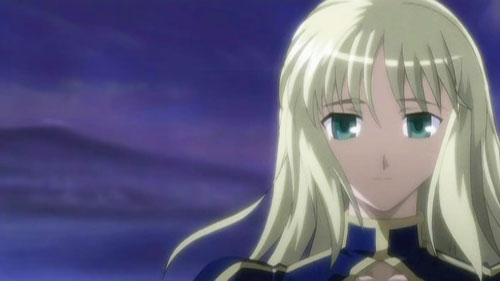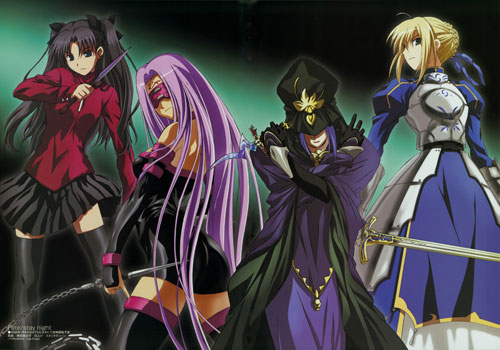
This week saw the release of the 24th and final episode of Type-Moon’s Fate/Night Stay. Spoilers follow.
I’ve been following it since the first episode, but never really got into posting about it with any regularity. Part of this had to do with the proliferation of FSN material on other blogs, and part of it had to do with the guilty pleasure of watching a show that was, in essence, a cross-breed between a Dragonball Z / One Piece / Naruto / Bleach fighting-challenge show and a Tenchi / Love Hina / Shuffle harem show. These are two genres of Japanese animation that are rather horribly overdone, and have produced some excellent shows. The production of additional, similar shows is not necessary to enrich the cultural landscape: this stuff has been done before.
As mentioned before, Fate / Stay Night is about a war between seven mages for a powerful artifact known as the Holy Grail. Each of the seven mages summons a servant, a legendary or mythical figure that will fight on the his master’s behalf. There are seven types of servants, each with differing strengths and weaknesses, but each servant is, more importantly, strongly associated with a “noble phantasm” that can be used to kill the other servants. The Grail War recurs every ten years, and ends when there is only one servant remaining. This time around, we got the following:
- Lancer: This servant is actually Cuchulain, legendary hero of Ireland. He wields a spear named Gae Bolg, which is appropriate to the actual legend. His role in the story is to introduce Shirou to the Grail War by stabbing him, and later as a sacrificial demonstration of another servant’s power. He serves the mysterious seventh master, a priest that is supposed to be overseeing the war, not participating himself.
- Archer: This servant is actually the future-self of Shirou, the main protagonist of the story. Archer servants are amongst the “knight” class of servants, and are invariably drawn from heroic figures. After Shirou becomes a great heroic figure in his adulthood, he ends up becoming a servant himself. His noble phantasm appears to be an ability to create an alternate reality in which he has a great many swords available to him (the writers liked to disarm him frequently). He serves Rin Tohsaka, the pig-tailed, haughty classmate of the main protagonist. He wasn’t summoned properly, and isn’t operating with all his skills and power. He’s a smarmy foil to Tohsaka’s arrogance.
- Rider: This servant is, oddly, the mythical creature Medusa (one of the three Greek gorgons). As Pegasus, the winged horse, was traditionally said to have sprung up from the Medusa’s blood when Perseus killed her, it somehow became her noble phantasm. By some contrivance, Pegasus is able to generate some phenomenally-powerful beam weapon. I have no idea where they got this idea. Her primary role in the show is to be a long-haired busty woman with a short skirt.
- Berserker: This servant is based nominally upon Hercules or Heracles. In the case of Berserker, the type of servant overrides nearly everything about the base mythical figure; the only thing Berserker really has in common with Hercules is the leather skirt and amazing strength. Berserker’s noble phantasm is the simple fact that it is necessary to kill him seven times before he’ll stay dead; the rest of his ability to threaten the other servants comes from tremendous strength and physical resiliency. He serves an extremely powerful German mage named Ilya. Ilya is utterly ruthless, but not especially evil. He spends a lot of time bellowing non-verbal rage.
- Caster: this servant is based upon the legendary figure Medea. Medea is best known as the first wife of Jason (of “and the Argonauts” fame). Her traditional story involves working some magic, so casting her in the role of the servant that is also a mage is appropriate. She killed her own master and bound herself to some sociopathic mortal that she supports through her own magic. Caster’s approach to the Grail War is basically to suck out the souls of the entire city to fuel her magic. She should have made a better villain than she turned out to be.
- Assassin: this servant is based loosely upon Sasaki Kojirou, somebody who I really only know as somebody that had a famous duel (that he lost) with Musashi Miyamoto. His noble phantasm is a sword technique that sounds impressive but is ultimately futile when used against one of the main characters. He was summoned by Caster, and as a second-hand servant isn’t as powerful as he might otherwise have been.
- Saber: based upon King Arthur, Saber represents all manner of mental gymnastics, having Caliburn, Excalibur, and Excalibur’s sheath all as noble phantasms, in addition to the grand-ultimate “Avalon” finishing move that came out of left field in the last episode. She serves Shirou, the main protagonist, and as such gets the most screen time of any of the servants.
Much of the plotline of Fate / Stay Night revolves around Shirou trying to figure out what the heck is going on. There is all manner of backstory, rules, and miscellaneous lore that is imparted to him by Tohsaka, Saber, and others throughout the course of the story. Much of what he is told doesn’t really do him any good. Some of it has the distinct ring of high-fantasy filler. Most of it is pretty interesting, even when it turns out to be not-applicable or patently false (no, it isn’t really the Holy Grail).
This show had a bit of a pacing problem, as there were some phenomenally-intricate discussions going on in the midst of what could have been presented as gripping, desperate, fast-paced battles. Such dialog can be readily accepted in a comic book, but once the swords start a-swinging, there’s little time to discuss the finer points of “Trace Sorcery.” That said, the core themes of the story are held firmly throughout: how do Shirou and Saber deal with their natures as selfless hero-types in the midst of a selfish free-for-all? Shirou cannot abide the idea of letting somebody else get hurt for him, especially a girl. Saber is a proud individual that has been saddled with an uncooperative master. They respect each other’s perspectives, but they’re both rather obstinate, making for some good character interaction throughout the series.
The production value throughout is solid for a television series, though it’s clear that the producers didn’t have the budget or time to make every fight scene play out as dramatically as they would have liked. The battle between Saber and Rider is by-and-large excellent, as are the fights between Saber and Gilgamesh (the Archer servant from the previous Grail War). Some of the decisions about when to burn lots of cells on quality action sequences are befuddling, though; there was a big build-up to the showdown with Caster, but the actual confrontation left much to be desired.

When I first looked at this series back in February, I gave it a B-; I liked the character designs and premise. When I looked at it again in May, this was upgraded to a B+; a good deal of this was in comparison to other shows like Shakugan no Shana, which had some premise and plot-progression issues that I just couldn’t get my head around. Having seen this series run all the way through from the hope and promise of its first few episodes, endured the loss of several interesting characters (only one Servant survives to get the Grail, then disappears), and endured a fair amount of poorly-placed plot-revelation dialog, I’m scaling back my rating a bit. Interesting character designs can only get you so far. The character development was appropriate and even-handed. Several of the fight scenes were excellent, but many lacked pizazz. The obscure mythological references scattered throughout sent me to Wikipedia a few times (Medea? Sure I recognize the name, but she was a classic hero’s wife, not a classic hero herself). Overall, Fate / Stay Night gets a B- as a totally-watchable, good series.
Yeah even I,I like it
Awesome…i didnt noe archer was really shiro…Kewl
Yeah, they weren’t clear about that in the show, but other material from TYPE/MOON indicates that this is the case.
It’s also told in the game, but that features a lot more stuff than is shown in the anime anyways.
That’s probably more a function of time constraints built into the format than anything else. When you’re putting together what amounts to a mildly-interactive graphic novel like Fate / Stay Night, you can cram a lot of exposition in.